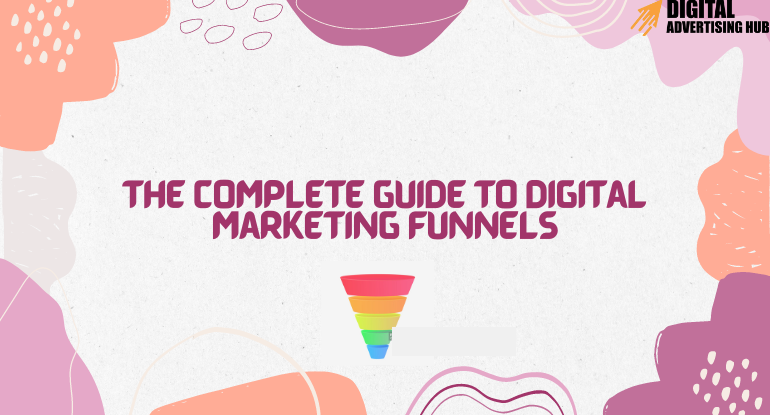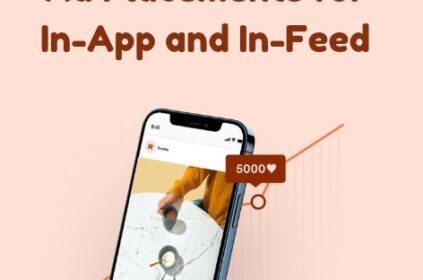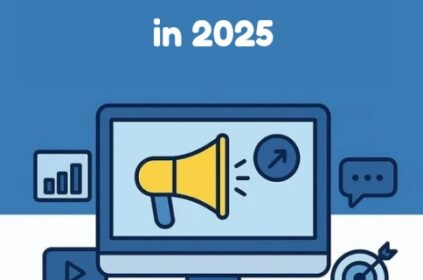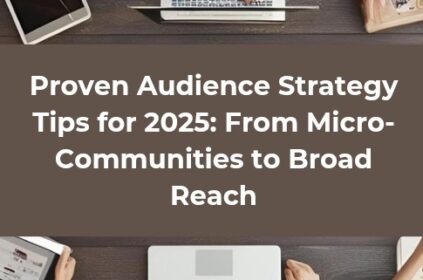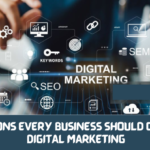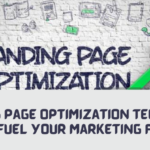Did you know attracting new customers online can be a science, not just a guessing game?
In the previous post, we explored 20 compelling reasons why every business, regardless of size or industry, should seriously consider embracing digital marketing. We discussed the vast potential of reaching new customers, building brand awareness, and ultimately driving sales growth through online channels.
But with so many options available, how do you translate that potential into a clear and strategic approach?
In this educative post, we’ll explore the concept of the digital marketing funnel, a powerful framework that helps visualize and optimize the customer journey from initial brand discovery all the way to conversion and beyond.
By understanding the different stages of the marketing funnel and implementing targeted strategies at each level, you can effectively nurture leads, address their needs, and ultimately convert them into loyal customers.
4 Stages of the Digital Marketing Funnel
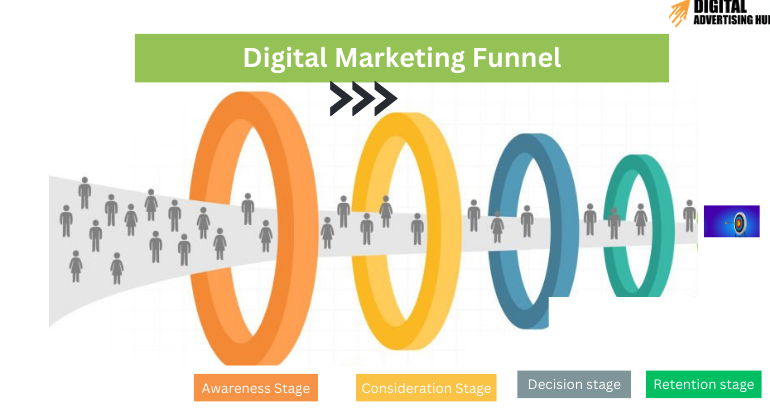
#1. Awareness Stage
This is the broadest stage of the marketing funnel, where your primary goal is to introduce your brand and product/service to a large, yet undefined audience. Here, the focus is on generating brand awareness and sparking initial interest. Potential customers may not be actively searching for a solution yet, but they’re receptive to discovering new options.
Here are some key strategies to excel in the awareness stage:
#1. Search Engine Optimization (SEO): Optimize your website and content to rank higher in search engine results pages (SERPs) for relevant keywords. This increases your visibility to potential customers actively searching for solutions related to your offerings. Learn more how to master SEO Content Optimization: Strategies for Higher Rankings.
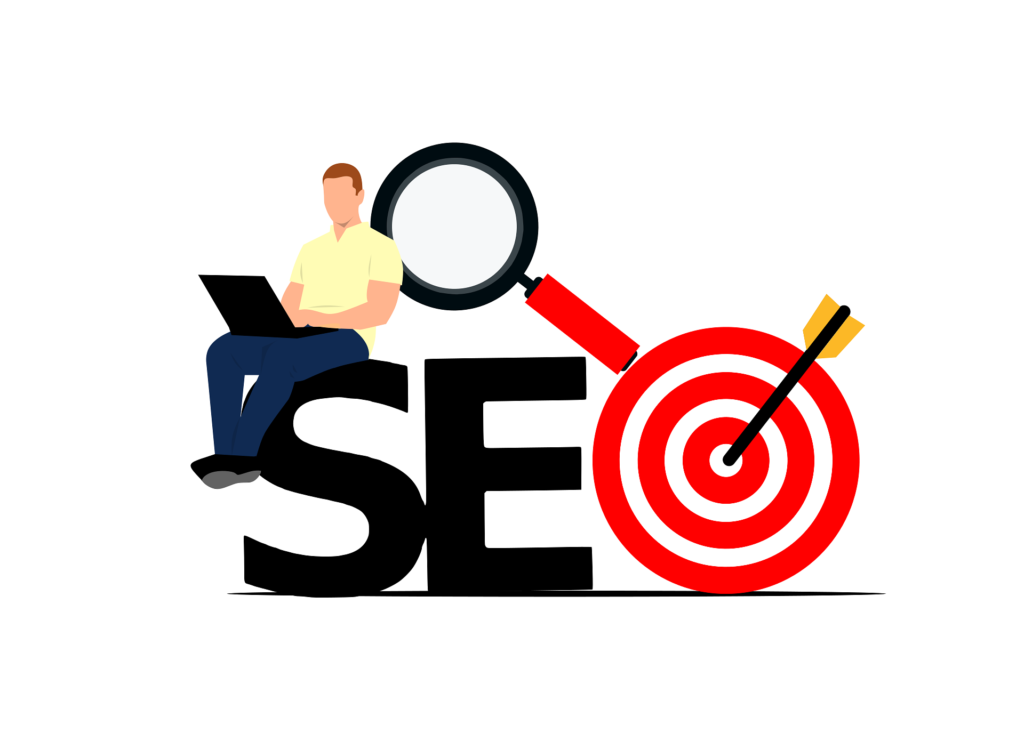
#2. Social Media Marketing: Establish a strong presence on social media platforms frequented by your target audience. Share engaging content, participate in relevant conversations, and run targeted social media ad campaigns to reach a wider audience.
#3. Content Marketing: Develop informative and valuable content (e.g., blog posts, infographics, videos) that addresses the general interests and pain points of your target audience. This establishes your brand as a thought leader and positions you as a trusted resource.
#4. Pay-Per-Click (PPC) Advertising: Consider running strategic PPC campaigns using platforms like Google Ads or social media advertising. This allows you to target highly specific demographics and interests, driving targeted traffic to your website or landing pages.
By implementing these strategies effectively, you can cast a wide net at the top of the marketing funnel, attracting potential customers who may not be immediately ready to buy but are open to learning more about your brand.
#2. Consideration Stage
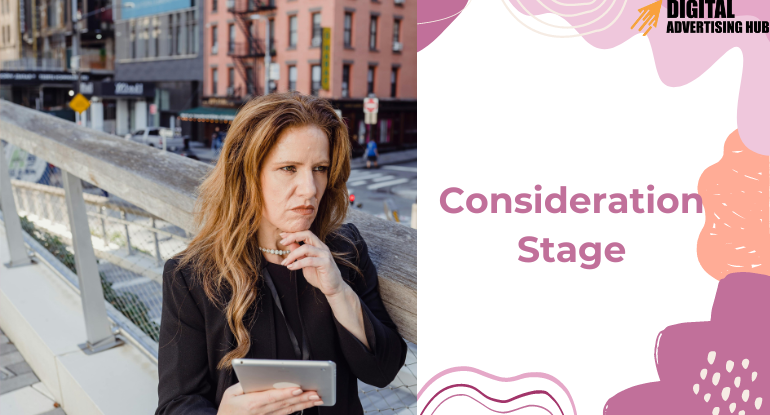
Once potential customers become aware of your brand through your awareness stage efforts, they move down the marketing funnel and enter the consideration stage. Here, they’ve identified a need or problem and are actively researching potential solutions.
Your goal at this stage is to nurture these leads, educate them about your offerings, and position yourself as the best solution to their specific needs.
Here are some key strategies to excel in the consideration stage:
#1. Targeted Email Marketing: Leverage email marketing to send informative and engaging campaigns tailored to the interests and needs identified during the awareness stage.
Segmentation allows you to send targeted emails with content that directly addresses their pain points and showcases how your product or service solves their problems. Learn how to Create a Successful Email Marketing Campaign.
#2. Educational Content: Develop valuable content such as ebooks, webinars, or blog posts that address the specific challenges faced by your target audience. Offer in-depth comparisons between your solution and competitors, highlight case studies demonstrating your success with similar clients, and provide educational resources that showcase your expertise.
#3. Free Trials or Demos: Offer free trials or product demos to allow potential customers to experience your product first-hand and see its value proposition in action. This allows them to test-drive your offering and removes a significant barrier to conversion.
#3. Decision Stage
The consideration stage has warmed up your leads, and they’re now actively comparing different solutions. Here, at the decision stage, your objective is to convince them that your product or service is the clear choice.
This is where you need to present compelling arguments that solidify your value proposition and nudge them towards conversion.
Here are some key strategies to excel in the decision stage:
#1. Case Studies and Testimonials: Showcase real-world success stories from satisfied customers through compelling case studies and testimonials. This social proof builds trust and demonstrates the effectiveness of your product or service in solving problems similar to those faced by potential customers.
#2. Product Comparisons and Reviews: Develop informative product comparisons that highlight the strengths of your offering compared to competitors. Leverage positive customer reviews and ratings on your website and other trusted platforms to further build confidence and credibility.
#3. Special Offers and Promotions: Offer limited-time discounts, free consultations, or bundled packages to incentivize immediate purchase decisions. This can tip the scales in your favor and encourage potential customers to choose your product over the competition.
#4. Retargeting Campaigns: Utilize retargeting campaigns to re-engage website visitors who have shown interest but haven’t converted yet. This allows you to stay top-of-mind and present them with targeted ads that remind them of the value you offer. Learn how to use facebook reels ads to retarget your website visitors.
#4. Retention Stage (Optional)
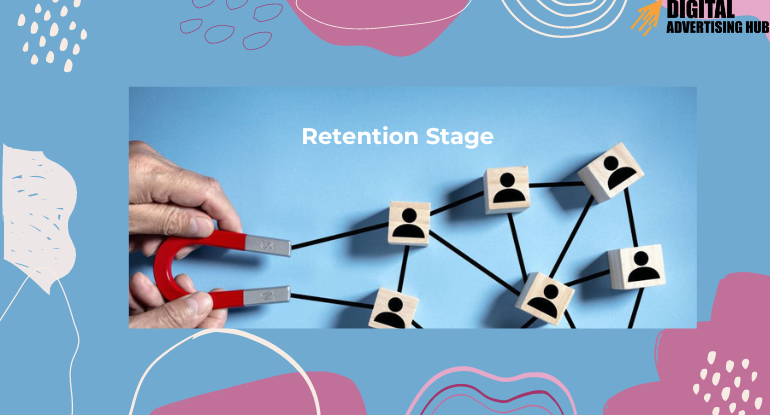
While the previous three stages focus on acquiring new customers, the retention stage in the marketing funnel takes things a step further. Here, the goal is to convert one-time buyers into loyal brand advocates who keep coming back for more.
This stage is not essential for every marketing funnel, but it’s incredibly valuable for businesses that rely on repeat customers or subscriptions.
Here are some key strategies to excel in the retention stage:
#1. Loyalty Programs: Implement loyalty programs that reward customers for repeat purchases, referrals, and engagement. This incentivizes them to continue using your product or service and fosters a sense of community around your brand.
#2. Personalized Email Marketing: Leverage customer data to personalize your email marketing efforts. Recommend products based on past purchases, offer exclusive deals for loyal customers, and provide valuable content that caters to their specific interests and needs.
#3. Exclusive Content and Offers: Reward loyal customers with exclusive access to new products, early bird discounts, or behind-the-scenes content. This makes them feel valued and strengthens their connection with your brand.
By nurturing customer relationships and fostering loyalty, the retention stage allows you to maximize the lifetime value of your customers and build a sustainable business model.
Valuable Tools and Resources For Building Your Marketing Funnel
Equipping yourself with the right tools is crucial for building and optimizing your digital marketing funnel. Here, we’ll explore some essential resources to streamline your workflow and maximize the impact of your marketing efforts.
1. Marketing Automation Tools
Gone are the days of manually managing every email, social media post, and lead interaction. Marketing automation platforms revolutionize the way you nurture leads and automate repetitive tasks throughout the funnel. Here are some popular options to consider:
#1. HubSpot Marketing Hub: A comprehensive platform offering tools for email marketing, landing page creation, lead scoring, and marketing analytics. For example, you can create automated email sequences tailored to different stages of the funnel.
A welcome email series might greet new subscribers at the awareness stage, while targeted product recommendations could nurture leads in the consideration stage.
#2. ActiveCampaign: A user-friendly platform known for its powerful automation features and visual workflow builder. Imagine creating a visual flowchart that automatically sends targeted emails based on a user’s website behavior or signup form selections. This allows for highly personalized experiences throughout the funnel.
#3. Mailchimp: A popular and affordable option ideal for businesses starting with email marketing. While Mailchimp offers basic marketing automation features, it excels in creating visually appealing email campaigns and managing subscriber lists.
You can segment your audience based on interests and demographics, allowing you to send targeted emails that resonate with specific groups within your funnel.
2. CRM Software
Customer Relationship Management (CRM) software goes beyond marketing automation by providing a centralized hub for all your customer interactions. CRM platforms like Salesforce or Zoho CRM store valuable customer data, track touchpoints across different channels, and help personalize your marketing efforts.
Here’s a practical example: Imagine a potential customer downloads a white paper from your website (awareness stage). This interaction is logged within your CRM. Later, they visit a product page but abandon their cart before checkout (consideration stage).
The CRM allows you to identify this behavior and trigger an automated email with a special discount offer to nudge them towards conversion (decision stage).
3. Free and Affordable Resources
Building a robust marketing funnel doesn’t require breaking the bank. Here are some free and affordable resources to get you started:
#1. Canva: A user-friendly graphic design platform offering free and premium templates for creating professional-looking social media graphics, presentations, and email banners. This allows you to visually enhance your marketing materials throughout the funnel.
#2. Unsplash and Pexels: These websites offer a vast library of free, high-resolution stock photos and videos that you can leverage to elevate the visual appeal of your landing pages, blog posts, and social media content.
#3. Hemingway Editor: This free online writing tool helps you improve the clarity and readability of your marketing copy. Strong, concise writing is essential for capturing attention and guiding leads through the funnel.
By strategically utilizing these tools and resources, you can build a powerful digital marketing funnel that attracts new customers, nurtures leads, and ultimately drives conversions and business growth.
5 Common Mistakes to Avoid While Building Your Digital Marketing Funnel
Even the most well-intentioned marketing efforts can fall short if you stumble upon these common pitfalls:
#1. Neglecting Buyer Personas
Skipping the crucial step of creating detailed buyer personas can lead to a misaligned funnel. Without a clear understanding of your ideal customer’s needs, wants, and pain points, you’ll struggle to craft targeted messages that resonate throughout the marketing funnel.
#2. Having Too Many Stages
While the four-stage funnel (awareness, consideration, decision, retention) provides a solid framework, cramming too many steps can create unnecessary friction and confuse your audience. Streamline your marketing funnel to focus on the essential actions that guide leads towards conversion.
#3. Weak Calls to Action (CTAs)
A strong call to action is the engine that propels leads through your marketing funnel. Vague CTAs like “Learn More” lack urgency and direction. Instead, craft clear, action-oriented CTAs that tell users exactly what you want them to do at each stage (e.g., “Download our Whitepaper,” “Start Your Free Trial”).
#4. Ignoring Mobile Optimization
With the majority of web browsing happening on mobile devices, neglecting mobile optimization is a recipe for disaster. Ensure your landing pages, email templates, and website are all mobile-friendly to provide a seamless user experience across all devices.
#5. Failing to Track and Analyze
Building a marketing funnel is just the beginning. To optimize your marketing efforts and maximize conversions, you need to track key metrics like website traffic, conversion rates, and lead sources. Utilize analytics tools to identify areas for improvement and continuously refine your funnel for better performance.
By avoiding these common mistakes and focusing on creating a buyer-centric, well-optimized marketing funnel, you can transform your digital marketing efforts and achieve sustainable business growth.
Conclusion
The digital marketing funnel offers a powerful framework for visualizing and optimizing the customer journey, transforming website visitors into loyal customers. By understanding the distinct stages of awareness, consideration, decision, and (potentially) retention, you can craft targeted strategies to nurture leads at each level.
Remember, building an effective marketing funnel is an ongoing process. It’s crucial to track key metrics like conversion rates and website traffic to identify areas for improvement. Don’t be afraid to experiment with different strategies and leverage the wealth of marketing automation tools and free resources available.
This digital marketing odyssey doesn’t have to be a solo adventure. Here are some ways to stay ahead of the curve:
Subscribe to our blog for ongoing insights and practical tips on digital marketing strategies.
Download our free guide on ” Sales Funnel Complete Guide: Stages and Strategies” for a step-by-step approach to funnel creation.
Take control of your customer journey today. Start building your digital marketing funnel and watch your business thrive!

